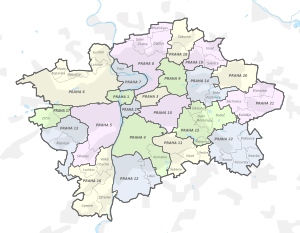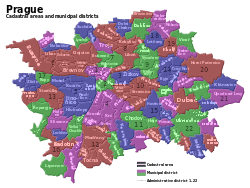Districts of Prague
Prague has a local-government structure of two or three tiers, depending on the area of town. At the top is the Magistrate of the Capital City of Prague (Czech: Magistrát hlavního města Prahy), which is responsible for public transport; waste collection; municipal police; firefighting; ambulance services; cultural activities; care of historical sites; the Prague Zoo; and other activities of citywide significance.
Since 1990, the city has been divided into 56 (since 1992, 57) self-governing municipal districts (Czech: městské části). The districts are responsible for parks and environmental protection; ordering equipment for schools and volunteer firefighters; some cultural and sports activities; activities for seniors; some social and health programs; cemeteries; and collection of fees for dog tags and the like. Another important activity of the municipal districts is the ownership, maintenance and, sometimes, sale of public property, especially public housing.
Since 2001, the 57 municipal districts have been grouped into 22 numbered administrative districts (Czech: správní obvody), for national-government purposes. One municipal district in each administrative district has responsibility for providing certain services for the entire administrative district. Those services include providing business licenses, identity cards and passports. The municipal district with such responsibility shares a name with the administrative district it serves. For example, the municipal district of Prague 19 provides those services to the municipal districts of Prague 19, Prague-Čakovice, Prague-Satalice and Prague-Vinoř. Residents of Satalice can get dog tags in their neighborhood but must go to Kbely, home of the Prague 19 government, to get an identity card.
Both the citywide government and the municipal districts have elected councils and mayors. The mayor of the Capital City of Prague is known as the primátor, which is sometimes translated into English as "lord mayor" (even though the Czech title carries no connotations of nobility).
From 1960 to 1990, Prague was divided into 10 districts. Those 10 districts are still used for addressing and transportation purposes and, for example, the organisation of courts and prosecutions. Street signs additionally add the name of the cadastral area (Czech: katastrální území), which usually reflects the name of an old municipality before its assimilation into the city of Prague. Thus, a sign in Kbely will say "Praha 9-Kbely," not "Praha 19." Prague residents are much more likely to use the name of a cadastral area or a 1960 municipal district than the name of a post-1990 district in everyday communication.
Table of administrative and municipal districts

| "Old" district | Current administrative district | Current municipal districts |
|---|---|---|
| Prague 1 | Prague 1 | Prague 1 |
| Prague 2 | Prague 2 | Prague 2 |
| Prague 3 | Prague 3 | Prague 3 |
| Prague 4 | Prague 4 | Prague 4, Kunratice |
| Prague 11 (part) | Prague 11, Šeberov, Újezd u Průhonic | |
| Prague 12 | Prague 12, Libuš | |
| Prague 5 | Prague 5 | Prague 5, Slivenec |
| Prague 13 | Prague 13, Řeporyje | |
| Prague 16 | Prague 16 (formerly Radotín), Lipence, Lochkov, Velká Chuchle, Zbraslav | |
| Prague 17 (part) | Zličín | |
| Prague 6 | Prague 6 | Prague 6, Lysolaje, Nebušice, Přední Kopanina, Suchdol |
| Prague 17 (part) | Prague 17 (formerly Řepy) | |
| Prague 7 | Prague 7 | Prague 7, Troja (district Troja has been separated additionally, as of 1992-01-01) |
| Prague 8 | Prague 8 | Prague 8, Březiněves, Dolní Chabry, Ďáblice |
| Prague 9 | Prague 9 | Prague 9 |
| Prague 14 | Prague 14, Dolní Počernice | |
| Prague 18 | Prague 18 (formerly Letňany), Čakovice (since 2007 Čakovice is part of administrative district 18) | |
| Prague 19 | Prague 19 (formerly Kbely), Miškovice, Satalice, Vinoř, Třeboradice | |
| Prague 20 | Prague 20 (formerly Horní Počernice) | |
| Prague 21 | Prague 21 (formerly Újezd nad Lesy), Běchovice, Klánovice, Koloděje | |
| Prague 10 | Prague 10 | Prague 10 |
| Prague 11 (part) | Křeslice | |
| Prague 15 | Prague 15, Dolní Měcholupy, Dubeč, Petrovice, Štěrboholy | |
| Prague 22 | Prague 22 (formerly Uhříněves), Benice, Kolovraty, Královice, Nedvězí |
Notes:
- In 2001, the Czech government ordered that all municipal districts serving entire administrative districts should have the same name as the administrative district. Thus, the municipal districts of Radotín, Řepy, Letňany, Kbely, Horní Počernice, Újezd nad Lesy and Uhříněves are now Prague 16 through 22, respectively. The old names persist as names of cadastral areas.
- All named districts officially begin with "Prague-", or, in Czech, "Praha-". Thus, the official name of Kunratice is "Prague-Kunratice" or "Praha-Kunratice."
List of cadastral areas

Key: Cadastral area (year joined to Prague) -- municipal district
- Hradčany (1784) – Prague 1, Prague 6
- Malá Strana (Lesser Town or Little Quarter) (1784) – Prague 1, Prague 5
- Nové Město (New Town) (1784) – Prague 1, Prague 2, Prague 8
- Staré Město (Old Town) (1784) – Prague 1
- Josefov (Jewish Quarter) (1854) – Prague 1
- Vyšehrad (1883) – Prague 2
- Holešovice (1884) – Prague 7, Prague 1
- Libeň (1901) – Prague 8, Prague 9, Prague 7
- Bohnice (1922) – Prague 8
- Braník (1922) – Prague 4
- Břevnov (1922) – Prague 6, Prague 5
- Bubeneč (1922) – Prague 7, Prague 6
- Dejvice (1922) – Prague 6
- Hloubětín (1922) – Prague 14, Prague 9
- Hlubočepy (1922) – Prague 5
- Hodkovičky (1922) – Prague 4
- Hostivař (1922) – Prague 15
- Hrdlořezy (1922) – Prague 9, Prague 10
- Jinonice (1922) – Prague 5, Prague 13
- Karlín (1922) – Prague 8
- Kobylisy (1922) – Prague 8
- Košíře – Prague 5
- Krč (1922) – Prague 4
- Liboc (1922) – Prague 6
- Lhotka (1922) – Prague 4
- Malá Chuchle (1922) – Velká Chuchle
- Malešice (1922) – Prague 10, Prague 9
- Michle (1922) – Prague 4, Prague 10
- Motol (1922) – Prague 5
- Nusle (1922) – Prague 4, Prague 2
- Podolí (1922) – Prague 4
- Prosek (1922) – Prague 9
- Radlice (1922) – Prague 5
- Smíchov (1922) – Prague 5
- Sedlec (1922) – Prague 6, Suchdol
- Strašnice (1922) – Prague 10, Prague 3
- Střešovice (1922) – Prague 6
- Střížkov (1922) – Prague 9, Prague 8
- Troja (1922) – Troja, Prague 7
- Veleslavín (1922) – Prague 6
- Vinohrady (1922) – Prague 2, Prague 3, Prague 10, Prague 1
- Vokovice (1922) – Prague 6
- Vršovice (1922) – Prague 10, Prague 4
- Vysočany (1922) – Prague 9, Prague 3
- Záběhlice (1922) – Prague 10, Prague 4
- Žižkov (1922) – Prague 3, Prague 10
- Čimice (1960) – Prague 8
- Ruzyně (1960) – Prague 6
- Ďáblice (čtvrť) (1960/68) – Ďáblice
- Dolní Chabry (1960/68) – Dolní Chabry
- Holyně (1960/68) – Slivenec
- Kunratice (1960/68) – Kunratice
- Lysolaje (1960/68) – Lysolaje
- Řeporyje (1960/68/74) – Řeporyje, Prague 13
- Čakovice (1968) – Čakovice
- Dolní Měcholupy (1968) – Dolní Měcholupy, Dubeč
- Horní Měcholupy (1968) – Prague 15
- Letňany (1968) – Prague 18
- Libuš (1968) – Libuš
- Kbely (1968) – Prague 19
- Kyje (1968) – Prague 14
- Komořany (1968) – Prague 12
- Miškovice (1968) – Čakovice
- Modřany (1968) – Prague 12
- Nebušice (1968) – Nebušice
- Štěrboholy (1968) – Štěrboholy
- Třeboradice (1968) – Čakovice
- Velká Chuchle (1968) – Velká Chuchle
- Háje (1968/74) – Prague 11
- Petrovice (1968/74) – Petrovice
- Přední Kopanina (1968/74) – Přední Kopanina
- Běchovice (1974) – Běchovice
- Benice (1974) – Benice
- Březiněves (1974) – Březiněves
- Dolní Počernice (1974) – Dolní Počernice
- Dubeč (1974) – Dubeč
- Hájek (1974) – Uhříněves
- Horní Počernice – Prague 20
- Hostavice (1974) – Prague 14
- Chodov (1974) – Prague 11
- Cholupice (1974) – Prague 12
- Klánovice (1974) – Klánovice
- Královice (1974) – Královice
- Koloděje (1974) – Koloděje
- Kolovraty (1974) – Kolovraty
- Křeslice (1974) – Křeslice
- Lahovice (1974) – Zbraslav
- Lipany (1974) – Kolovraty
- Lipence (1974) – Lipence
- Lochkov (1974) – Lochkov
- Nedvězí (1974) – Nedvězí
- Písnice (1974) – Libuš
- Pitkovice (1974) – Uhříněves, Křeslice
- Radotín (1974) – Radotín
- Řepy (1974) – Prague 17, Prague 6
- Satalice (1974) – Satalice
- Slivenec (1974) – Slivenec
- Sobín (1974) – Zličín
- Stodůlky (1974) – Prague 13, Řeporyje
- Suchdol (1974) – Suchdol
- Točna (1974) – Prague 12
- Třebonice (1974) – Prague 13, Řeporyje, Zličín
- Uhříněves (1974) – Uhříněves
- Újezd nad Lesy (1974) – Prague 21
- Újezd u Průhonic (1974) - Újezd u Průhonice
- Vinoř (1974) – Vinoř
- Zadní Kopanina (1974) – Řeporyje
- Zbraslav (1974) – Zbraslav
- Zličín (1974) – Zličín
- Černý Most (formed in 1988 from parts of Kyje, Hostavice, Dolní Počernice and Horní Počernice) – Prague 14
- Kamýk (formed in 1989 from parts of Lhotka and Libuš) – Prague 12
Source: Kuča, Karl (2002). Města a městečka v Čechách, na Moravě a ve Slezsku Par-Pra (V. díl). ISBN 80-7277-039-X.
Beyond these 112 cadastral areas, many other Prague settlements, quarters and housing estates are perceived as districts although they don't constitute their own cadastral areas. For example, Barrandov, Spořilov, Sídliště Košík, Zahradní Město, Pankrác, Letná, Bubny, Zlíchov, Klíčov, Butovice, Klukovice, Kačerov, Jenerálka, Šárka, Strahov, Chodovec, Litochleby, Dubeček, Lázeňka, Netluky, Zmrzlík, Cikánka, Kateřinky, Hrnčíře, Pitkovičky, Lahovičky, Dolní Černošice, Kazín, Závist, Baně, Strnady and many others. The biggest panelák complexes are Jižní Město (South City), Severní Město (North City) a Jihozápadní Město (South-West City), all of which consist of partial housing estates. Most of Prague's panel housing estates from 1960s to 1980s have names including the Czech word sídliště', which refers to a post-World War 2 eastern bloc housing estate. Many local names originate from names of historic villages in today's Prague area.
See also
- ISO 3166-2:CZ, ISO subdivisions codes for the Czech Republic (include codes for districts of Prague)
External links
- Map of Prague administrative and municipal districts from the Czech Statistical Office
- Description of 2001 local-government reform in Prague from Prague 19 (in Czech)
- Prague districts at a glance
.jpg)